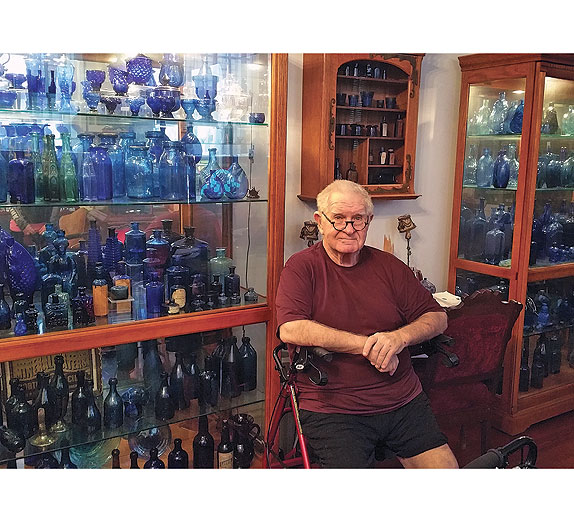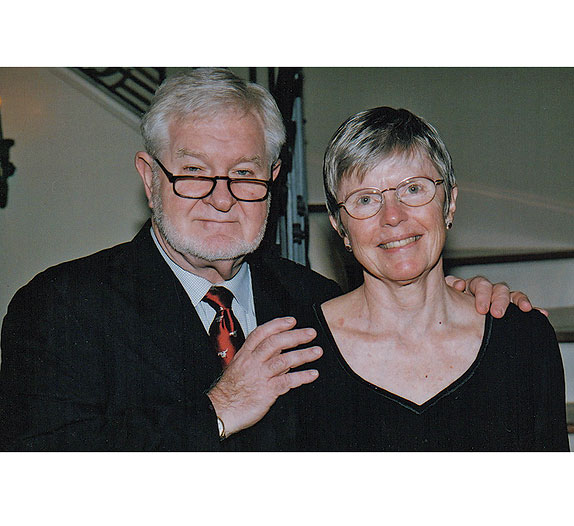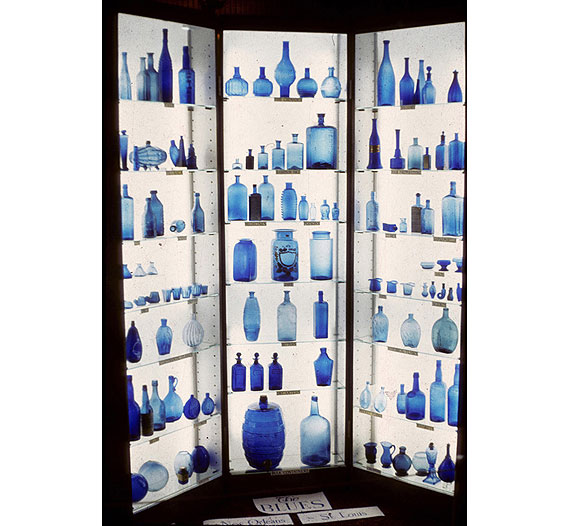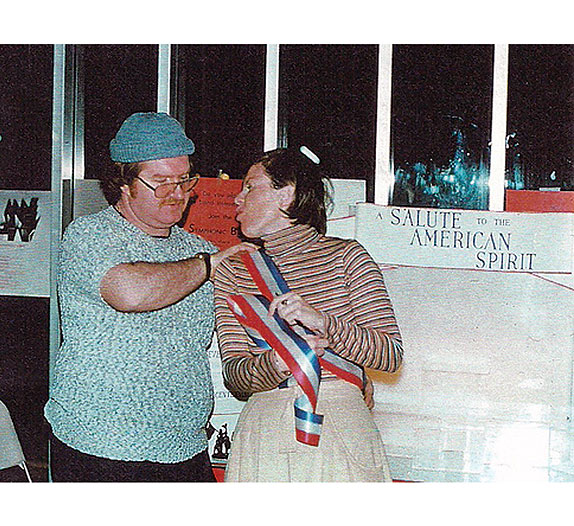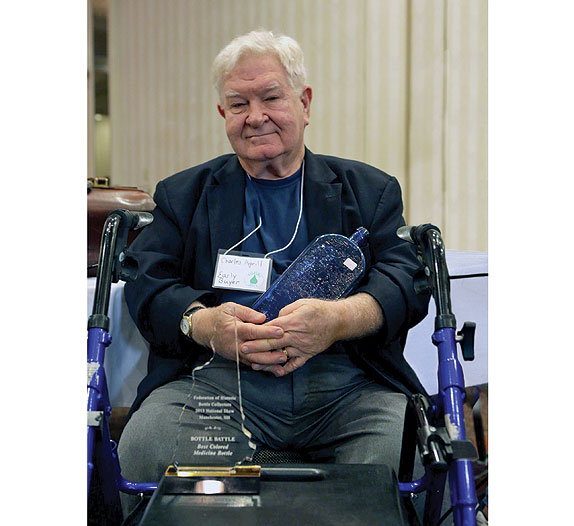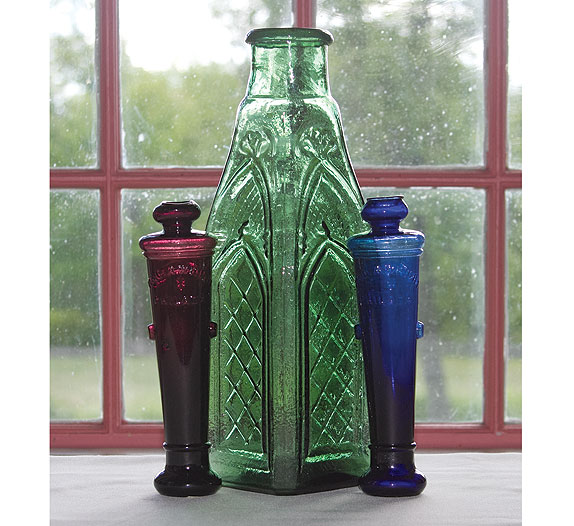The Dr. Charles & Jane Aprill Collection
A Labor Of Love
Beginning a Collection
Jane and I were married in 1963 just two weeks after we graduated from college. That fall, I entered medical school. When I graduated in 1967 we had three children. It was in 1967 while driving around New Orleans we came upon a quaint shop on Magazine Street named "Pontils and Pegs". Curious, because of old bottles in the window, we went in. We were amused by the names embossed on some of the bottles. "Dr. Kilmer’s Swamp Root Kidney Liver & Bladder Cure" and "Glover’s Mange Cure" were among our favorites. The proprietor said that old bottles like these were dug from privies and wells and even found under houses.
We bought several for a couple of dollars and the next weekend sent our two oldest children crawling under houses in the neighborhood and under the house of a colleague’s mother which dated back to the 1850’s. While there, the colleague’s mother said she had some old bottles that had been in her family for many years, coming down from an ancestor who was a pharmacist at the time of the civil war. She presented us with two handle jugs, one globular and the other a flattened chestnut form. Both brilliant amber with millions of tiny seed bubbles. Both bottles were pontiled. The jug had an iron pontil, the chestnut an open pontil. She asked if we wanted them. We immediately said yes. They were absolutely pristine mint and the first mint bottles that we had ever seen. This was all in 1967.
On a drive across lake Pontchartrain, doing some "antiquing", we stopped at a shop in Ponchatoula and an old odd-looking bottle caught Jane’s eye. It had a crude arch configuration on each of its four panel and the dealers told us this was a "cathedral pickle". Jane fell in love with this bottle and we purchased it for $25.00. This was the most we had ever spent on a bottle. Our collection was growing, and we now had multiple sizes of Bromoseltzers and Bromo Caffeine’s, three of the four Carter’s Inks, a "Piso’s Cure" and three St. Louis medicine bottles, amber, blue, and purple.
In 1968, I was an intern. One weekend I had worked in a hospital emergency room and received a paycheck of $250.00. This was great because at that time an intern’s salary was $120 a month. Needless to say, money was tight. The weekend after I had worked in the emergency room, we were visiting my parents in Franklin, Louisiana and on the way back to New Orleans passed through the small town of Jeanerette, Louisiana. On the side of the road was a sign "Bottle Show and Sale". We had to stop in. There are a half dozen dealers including one "big time dealer from Texas" by the name of Jim Cope. His table was filled with mint bottles. We were in awe as the majority of our collection at this time were dug bottles. Two caught our eye. One was a large magnificent "apple green" Cathedral Pickle with lattice windows embossed on three sides. The other was a square cobalt blue bottle, London Royal Imperial Gin. We fell in love with these bottles. Mr. Cope had $100.00 on the pickle and a $150.00 on the gin. The total was $250.00, exactly what I had made working the emergency room the weekend before. I looked at Jane and she looked at me and said, "endorse the check" and that was that. We were on our way….
Specializing in Blue
We soon realized that we liked all of the genres of bottles but that one could not collect them all. We decided we would specialize and try to get the best we could across all the genres of collecting but limiting it to the color blue.
I completed my radiology training in 1971 and entered the Navy Active Reserve in Pensacola, Florida between ’71 and ’73. I made almost a dozen of trips to the New England area to attend live auctions, flying "military standby" which was really cheap. During those years we collected blue creamers, some Harrison’s inks, and a few relatively inexpensive blue flasks. With my Navy salary and extensive moon lighting our expendable income had increased and we could afford some nicer bottles.
In 1972, at a Skinner’s auction in Bolton, Massachusetts, I saw a Blue Fish Bitters. I held my hand up to bid but the bids went over the estimate very quickly and well out of my price range. The bottle was sold to Elvin Moody and I believe it may have been one of the first American glass bottles to sell for more than $1000.00.
In 1973, we took a trip to Ohio to Garth’s Auction Barn to see one of the Wettlaufer auctions and there saw some amazing bottles and were able to purchase a GII-24 Louisville double eagle in a brilliant sapphire blue. At the time, it was the prize of our collection. Then at a Louisville bottle show, we got a blue Corn For The World from Dave Goad, "the traveling bottle man".
Collecting Cannons
In 1974, I was in practice in Houston, Texas. We had the opportunity to buy three figural cannons from Rick Meyer of Atlanta, a Gayen/Altona, a large olive green R. G. & A Wright and a miniature blue R. G. & A Wright. I became enamored of the figural cannons and ultimately had a collection of 26 different cannons including two large R.G. & A Wright cannons, olive green and a "puce" example, as well as an amber General Scott’s New York Artillery Bitters and an olive green Barto’s Bitters.
Only two miniature R.G. & A. Wright cannons were known to exist, one cobalt blue and another a deep amethyst. Originally they belonged to a great collector of early American glass in the first half of the 20th century, Gordon Bass. The Bass collection was auctioned at Skinner’s in Bolton, Massachusetts in the early 60’s. Tom McCandless of New Jersey purchased the amethyst example. Rick Meyer from Atlanta was reportedly rushing to the auction house and was speeding, caught by the police, and arrested. He was reportedly given one phone call from jail, and he made that call to the auction house to bid on the blue cannon, which he got for $500.00. This is the one I bought from Rick in 1974.
I desperately wanted the amethyst cannon because I loved it and just thought the two of them belonged together. Over the next thirty years or so, I saw Mr. McCandless at bottle shows and bottle auctions and visited with him at his home. Incidentally, he had a wonderful collection of antique "mousetraps". Each time our paths crossed I offered to buy the amethyst cannon, at one time saying, "What will it take to get it". His response was always gentlemanly, "Charles, it’s really not for sale". Jane and I visited Tom and Marian on several occasions enjoying their mousetrap collection and all of their wonderful bottles but particularly the amethyst cannon. On our last visit, I said to Tom, "Well, I know it is not for sale, but Tom you’re older than me", and with that I waited. Tom passed in 2010, God Bless his soul, and his collection came to auction in 2011. I had the opportunity and did win the amethyst cannon and now these two miniatures sit in a window beside my chair in our study and I look at them every day.
By 1974, our collection was approaching 100 bottles and when we finally obtained the miniature paneled Carter’s ink, we felt that we had "all of the great blue bottles there were to have". We were so impressed with our collection.
The Gardner Sale & The Blaske Sale
In 1975, the Charles B. Gardner collection came to auction. Jane and I attended the first auction on September 25th, 26th, and 27th, 1975 and were absolutely blown away. First, at this auction there was an amazing group of the great collectors from all over the country. We met old friends and new friends and got the autographs of almost 100. There were so many magnificent bottles in that collection. We made a few purchases including an un-embossed blue barrel, a "Wynkoop’s Katharismic Honduras Sarsaparilla" and a blue flattened handled chestnut. It was truly an amazing event. Jane attended the second sale on November 20th, 21st, and 22nd of 1975. I stayed home for that one. She got the gallon Harrison’s Columbian ink and the half-gallon amber Willington pickle. There is a story, "untrue", that Jane had the two bottles packed in separate boxes and bought a plane ticket beside her on the way home for the bottles. In those auctions we saw the Blue Homestead Cabin, the blue Sazerac bitters which went for wonderful prices and I saw and coveted the Lion of St. Marc Cologne (item #1377). Elvin Moody had purchased the Cologne for his wife. Some twenty years later, they sold it to us. Incidentally, in the early 90’s Elvin Moody sold the blue fish bitters to us.
We attended the live auction of Judge Blaske’s flask collection in 1983. We had a line of credit at our bank and hoped to obtain one or two flasks. Early in the auction, the blue "firecracker" came up. I loved that flask and so I raised my hand just to say I had bid on that wonderful bottle. The auctioneer went on and on and then stopped and said sold and said a number, which sounded familiar. I took my hand down and looked, it was my number. I was floored. The price was reasonable, and I only assume that other collectors were saving their money for items to come up later or maybe they weren’t paying attention. As far as I was concerned, we had a successful auction. However, as the day went on, we acquired a total of six blue flasks from Judge Blaske’s collection including a blue G-IV "Masonic". There is a nice piece about that flask in the Blaske Auction Catalog , Item #525. They got it from a Canadian dealer, site unseen, for approval. The Judge opened the package late one night, on returning from a trip, "weary". When he saw it, the Judge was suddenly "wide awake" and they stayed up for several more hours, "washing and admiring the bottle".
Attending Bottle Shows
During the 70’s, Jane and I attended many shows in the south, southeast, and southwest. Jane loved to make exhibits and had a wonderful artistic touch. We put up a display at almost all the shows we attended and did recoup a number of Best in Show blue ribbons. In 1976, we attended the Great Expo in St. Louis and put up a display of 115 blue bottles. That was a truly thrilling event.
The Polaroid Piece
In the late 70’s, a dealer sent me a Polaroid photograph of a blue wine bottle embossed with leaves and a cluster of grapes on a stump. This bottle was blue and un-embossed. However, it is exactly like the Imperial / Levee / J.Noyes / Hollywood / Miss figural bottle. The amber is embossed and uncommon but blue examples are unembossed and extremely rare. The dealer who sent the picture said that the collector who owned the bottle was not interested in selling. He would not tell me who the collector was but had sent the picture just as a tease. We put the picture on our refrigerator. In the early 1990’s, I received a phone call and the dealer said the collector wanted to sell. I jumped at the chance and we obtained the bottle and I was able to take down the polaroid which had been on our refrigerator for some 25 years.
An Auction Fifty Years in the Making
We continued collecting through the 80’s and 90’s although live auctions became more and more uncommon and of course now, all auctions are online. We obtained a few blue bottles every year. By 2016 our collection had reached 300 blue bottles across all collecting genres. We also had some non-blue bottles including 50 creamers and 50 snuff bottles, as well as two dozen cathedral pickles and pepper sauces.
We have been lucky at many auctions and also lucky in private sales from some wonderful dealers. Jane and I decided we would stop active collecting when we reached the age of 75. We both agreed that it would be wonderful to auction our collection so that we could enjoy watching the bidding on our various prized pieces. Unfortunately, Jane passed before the auction, in March of 2017. I miss her dearly but think that she is probably looking down from above and will enjoy watching the dispersal of this 50 year long labor of love.
Sincerely,
Charles Aprill, M.D.
We are very excited to be offering the renowned collection of Dr. Charles & Jane Aprill at auction this year. For more information about the sale of this amazing collection is available on the Dr. Charles & Jane Aprill Collection page and on the Aprill Collection - Auction 172 page.
Please note the two cannons and the pickle pictured above remain with Dr.Charles Aprill and family as treasured reminders of his exceptional collection.

